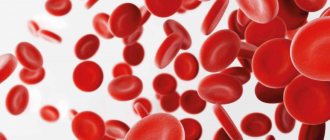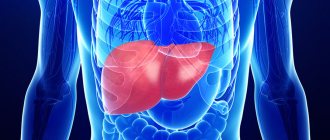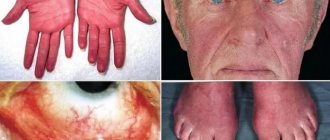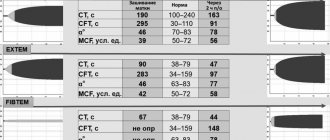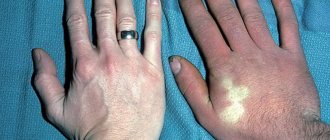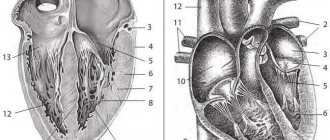Polycythemia vera
(IP) is a clonal myeloproliferative disease of a chronic nature with a relatively benign course, affecting hematopoietic stem cells and accompanied by the proliferation of three hematopoietic lineages. It is characterized by an increase in the number of red blood cells, an increase in the concentration of hemoglobin, blood cells (leukocytes, erythrocytes, platelets) and total blood volume.
Polycythemia vera is also known as Vaquez's disease, true, or red, erythremia. Belongs to orphan (rare) diseases. It mainly affects people over 60 years of age, more often men. In young people, the disease is less common but has a more unfavorable course.
According to ICD-11, IP is assigned code 2A20.4.
Causes
The exact causes of the disease are still unknown. Scientists suggest that hereditary predisposition, exposure to ionizing radiation and toxic substances play a significant role in the development of pathological changes.
In 20-30% of patients with erythremia, chromosomal abnormalities are detected ( https://cyberleninka.ru/article/n/klinicheskie-rekomendatsii-po-diagnostike-i-terapii-ph-negativnyh-mieloproliferativnyh-zabolevaniy-istinnaya-politsitemiya-1/viewer ).
The likelihood of developing erythremia increases in funeral home employees who embalm bodies, in people who are forced to frequently come into contact with gasoline and other petroleum products, and in those exposed to low doses of radiation. In people who survived the atomic bombing of Nagasaki and Hiroshima, a high risk of developing IP was not observed.
Diagnostic criteria
The clinical picture of polycythemia is directly caused by an increase in the volume of circulating blood, and in particular red blood cells, a decrease in blood flow speed, and thickening of the blood, leading to its viscosity. In turn, this leads to a deterioration in the quality of microcirculation and the development of a tendency to thrombus formation.
During diagnosis, criteria are identified according to which the course of polycythemia is classified into two categories - A or B. Category A is characterized by:
- increase in the content of red blood cells in the bloodstream: in women – 32 ml/kg and men – 36 ml/kg;
- blood oxygen saturation is regarded as normal (more than 92%);
- splenomegaly (enlarged spleen).
List of diseases for permanent disability
Category B is established if the patient has:
- leukocytosis (increased level of leukocytes) more than 12*109 U/l, not accompanied by infection or intoxication;
- thrombocytosis (increase in platelet count) over 400*109 U/l without signs of bleeding;
- an increase in the concentration of alkaline phosphatase, the number of neutrophils without symptoms of infectious infection or intoxication;
- increased plasma binding of vitamin B12.
Reference! The diagnosis is considered confirmed in the presence of any 2 manifestations belonging to categories A and B or 3 manifestations belonging to category B.
Symptoms of the disease
Clinical manifestations of IP are divided into 2 groups:
- Plethoric (“plethora” - plethora) syndrome - the mass of red blood cells increases, due to which:
- headaches and dizziness occur;
- pressure increases;
- the skin and mucous membranes acquire a bluish or red-cherry tint;
- disturbing skin itching;
- the conjunctiva turns red;
- vision deteriorates, spots appear before the eyes;
- erythromelalgia develops - small vessels periodically dilate, which provokes redness of the fingers and toes, unbearable burning pain and burning;
- thrombosis and cerebrovascular insufficiency occur;
- angina attacks are observed.
2. Myeloproliferative syndrome is caused by hyperplasia of three hematopoietic lineages: erythroid, granulocytic, megakaryocyte
With polycythemia vera, myeloid metaplasia of the spleen and splenomegaly often develop (the size of the spleen increases). The most common complications are thrombosis (occurring in 39% of patients), thromboembolism and bleeding (gingival, nasal, gastrointestinal, menorrhagia).
The risk of transformation of polycythemia vera into acute myeloid leukemia is 5%, and into myelofibrosis - less than 10% ( https://cyberleninka.ru/article/n/istinnaya-politsitemiya-sovremennye-predstavleniya-o-pathogeneze-diagnostike-lechenii/viewer ) .
With polycythemia vera symptoms
depend on the stage:
- Stage I (asymptomatic). The main signs (plethora, erythrocytosis, skin hyperemia) are moderate, the number of leukocytes and platelets, the size of the spleen is normal, there are no vascular complications or manifestations of fibrosis. Blood pressure increases and blood circulation is disrupted. Duration – 5 years or more.
- Stage IIA (erythraemic). There is no myeloid metaplasia of the spleen. Skin hyperemia, hepatosplenomegaly, and scleral injection are evident. A general blood test shows thrombocytosis, erythrocytosis, neutrophilia, and bone marrow examination shows focal myelofibrosis, total three-line hyperplasia, and often reticulin fibrosis. Thromboembolic complications are common.
- Stage IIB (erythraemic). Myeloid metaplasia is present. Hepatosplenomegaly develops - the liver and spleen simultaneously increase in size. A general blood test reveals leukocytosis, shifted to myelocytes, and a possible decrease in the number of platelets and red blood cells. When diagnosing bone marrow, focal myelofibrosis and panmyelosis are noticeable.
- Stage III (posterythremic, anemic) – terminal. The concentration of blood cells and hemoglobin sharply decreases. Symptoms of tumor intoxication become noticeable, and hemorrhagic complications occur. Myelofibrosis develops and blast crisis occurs.
Publications in the media
Polycythemia vera (polycythemia vera) is a neoplastic disease accompanied by an increase in the number of red blood cells, white blood cells and platelets. The source of tumor growth is the precursor cell of myelopoiesis. Frequency. 0.6 cases per 10,000 population. The predominant age is elderly. Genetic aspects • Polycythemia vera (*263300, ) • Hereditary isolated erythrocytosis (*133100, 133110, ) • Polycythemia with increased ATP content (*102900, ) - increased pyruvate kinase activity with a decreased content of 2,3-diphosphoglycerate. Pathogenesis • Increased proliferation of all three lineages of hematopoiesis (with a predominance of erythrocyte) leads to an increase in Ht, a decrease in blood flow in tissues and a decrease in their oxygenation, an increase in cardiac output • The appearance of foci of extramedullary hematopoiesis in the liver and spleen.
Clinical picture • Plethoric syndrome •• Headache •• Dizziness •• Visual impairment •• Angina pain •• Skin itching •• Paresthesia •• Arterial hypertension •• Tendency to thrombosis (less commonly, hemorrhagic syndrome) • Myeloproliferative syndrome •• General weakness • • Increased body temperature •• Bone pain •• Feeling of heaviness in the left hypochondrium •• Splenomegaly (less commonly, hepatomegaly) as a result of the appearance of foci of extramedullary hematopoiesis and venous stagnation. Laboratory research . Trephine biopsy of the bone marrow (three-line hyperplasia of the bone marrow with a predominance of erythropoiesis, absence of iron deposits). Differential diagnosis . Other polycythemias • Primary •• Erythrocytosis familial type •• Erythrocytosis of the Volga region (endemic foci) • Secondary •• Physiological erythrocytosis due to poor tissue oxygenation ••• Low pO2 (for example, in high mountains) ••• COPD accompanied by hypoventilation ••• Cardiac shunt from right to left ••• Hemoglobinopathies with high oxygen affinity ••• Carboxyhemoglobin in “smokers' polycythemia” ••• Deficiency of erythrocyte 2,3-diphosphoglycerate ••• Hereditary increase in ATP content in erythrocytes ••• Insufficiency of 2,3-diphosphoglycerate mutase • • Increased erythropoietin levels ••• Kidney disease ••• Hypernephroma or renal carcinoma ••• Renal cyst and hydronephrosis ••• Bartter's syndrome ••• Kidney transplantation ••• Erythropoietin-producing tumors ••• Hypersecretion of the adrenal cortex ••• Exogenous androgens •• Relative erythrocytosis (pseudopolycythemia, false polycythemia) - increased Ht due to decreased plasma volume (excessive diuresis, nasogastric drainage, severe gastroenteritis, especially in young children, burns). The erythrocyte mass remains within normal limits. Diagnostic criteria . The diagnosis confirms the presence of three main criteria or a combination of the first two main criteria and any of two additional criteria • Main criteria •• Increased erythrocyte mass •• Arterial blood oxygen saturation above 92% •• Splenomegaly • Additional criteria - leukocytosis, thrombocytosis, increased alkaline phosphatase activity of leukocytes and an increase in the concentration of vitamin B12 in the blood serum • Other criteria •• Hyperuricemia •• Hypercholesterolemia •• Increased concentration of histamine in the blood •• Reduced concentration of erythropoietin in the blood.
TREATMENT. Removal of red blood cells from the bloodstream or suppression of erythropoiesis, a combination of both methods is possible • Bloodletting as a method of eliminating red blood cells is the safest type of therapy, carried out until the Ht level decreases below 50%. Inhibition of the hematopoietic function of the bone marrow is necessary when it is impossible to correct Ht with bloodletting alone or when there is increased activity of other cell lineages • Radioactive phosphorus effectively regulates the activity of the bone marrow and is well tolerated; therapy is especially beneficial for patients in older age groups • Chemotherapy. Chlorambucil is quite effective, but a leukemic effect is possible. Currently, hydroxyurea (and its derivatives) is used for polycythemia vera. Current and prognosis . Survival is 7-10 years, without treatment - 2-3 years. With bloodletting, the main complications are thromboembolic and cardiovascular. After chemotherapy, neoplasia is possible, incl. leukemic transformation of bone marrow. Concomitant pathology • Budd–Chiari syndrome • Thrombosis of mesenteric arteries. Synonyms • Erythremia • Primary polycythemia • Vaquez disease • Osler disease • Vaquez–Osler disease
ICD-10 • D45 Polycythemia vera
Note. The term "polycythemia" means an increase in the number of red blood cells (regardless of the number of white blood cells and platelets). The term “erythrocytosis” is more accurate. Application. Gaisböck syndrome: polycythemia with arterial hypertension, plethora, swollen vessels of the head, neck, arms, enlargement of the left ventricle of the heart; Characterized by excess body weight, possible nosebleeds and stroke.
Diagnosis of the disease
At the initial appointment, the doctor listens to complaints and examines the medical history. He also conducts a physical examination, during which he examines the skin and mucous membranes, assessing their pigmentation, the presence of hemorrhages, edema, and trophic disorders.
Then the specialist refers the patient for laboratory and instrumental diagnostics, which may include:
* clinical, biochemical and molecular genetic blood analysis;
* coagulogram;
* study of iron metabolism;
* blood test for HIV infection and hepatitis;
* trephine biopsy of the bone marrow followed by cytological, histological and histochemical analysis of the biopsy;
* Dopplerography of cerebral arteries;
* Ultrasound of the abdominal organs.
The main marker for diagnosis is the Jak-2 gene mutation, which occurs in 95% of patients. Also, in patients with PV, the level of erythropoietin should be reduced or at the lower limit of normal and never elevated, which is initially used for differential diagnosis.
Can this disease be controlled?
With regular therapy, which protects against thrombotic complications, bleeding and infections, the life expectancy of people with PV is almost the same as that of their healthy peers. The essence of therapy is to reduce the production of blood cells and prescribe drugs that reduce the risk of thrombosis. The doctor selects the regimen, having previously calculated which risk group for thrombosis the patient belongs to.
The simplest method of treatment is the use of regular aspirin to prevent arterial thrombosis, which provokes the development of stroke and myocardial infarction. Another traditional method is conventional blood exfusion, that is, bloodletting. Periodically, 500 milliliters of blood are taken from a person two to three times a week until the hematocrit level decreases to normal.
Indications for MSEC
A patient with erythremia is referred to undergo a medical and social expert commission (MSEC) by his attending physician, who is guided by the presence of a certain number of indications in a particular patient. These include:
- Stage II of the disease when there is a need to transfer the patient to a position of lower qualifications, another profession, or the need to reduce the volume of activities performed;
- terminal stage of erythremia;
- the course of the disease with vascular complications leading to significant dysfunction of the cardiovascular system.
Determination of disability
When conducting a commission to determine the degree of disability, medical experts are guided by the following criteria. A patient is not entitled to disability in case of a latent, indolent (sluggish) form of erythremia without symptoms of progression with unexpressed dysfunction of organs.
Group 3 is assigned to Vaquez disease with moderately manifested blood and immune dysfunctions during the treatment provided to the patient. Group 2 is provided for severe deviations in the activity of the circulatory and immune systems during the therapy.
Group 1 is assigned to the terminal stage, accompanied by significant impairments in the functioning of the circulatory and immune systems, against the background of developing acute leukemia. The category “disabled child” is provided for polycythemia with blood and immune dysfunction, starting from a moderate degree and further on the background of treatment.
Changes in working conditions
With this disease, young patients suffering from stages I and IIA erythremia in remission are considered to be able to work. Moreover, their condition should not be complicated by vascular pathologies.
For patients with polycythemia there are certain contraindications and the following working conditions are recommended:
- Stage I. Activities that require excessive physical effort or psycho-emotional stress are prohibited. Work in an unfavorable microclimate and interaction with hemotoxic substances are also contraindicated.
- Stage II. Work associated with a forced uncomfortable body position, moderate physical activity and neuropsychic stress, vibration exposure, exposure to heights, changes in temperature, pressure, etc. is not recommended.
- Stage III does not allow patients to work under normal production conditions for a healthy person.
Symptoms of polycythemia vera
